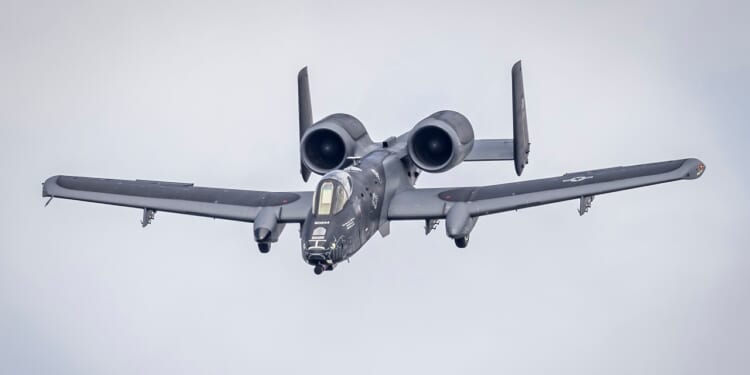Both the Russian and American aircraft are entering the end of their useful service lives, as ground anti-air defenses grow increasingly sophisticated.
In the 1970s, the US Air Force unveiled the Fairchild Republic A-10 Thunderbolt II, a heavily-armored, low-flying close air support (CAS) aircraft. Built around a massive internal cannon, the A-10—soon to be nicknamed the “Warthog” by its pilots—was designed primarily to destroy Soviet tanks and armored vehicles sweeping across the open plains of Eastern Europe.
The Soviets received the memo, and they responded in kind. Within only four years, they had produced their answer, the Su-25 “Frogfoot”—a similar CAS aircraft that was simpler, faster, and just as hard to kill.
| Aircraft | A-10 Thunderbolt II (“Warthog”) (United States) | Su-25 Frogfoot (Soviet Union / Russia) |
| Year Introduced | 1977 | 1981 |
| Number Built | 713 | ~1,000–1,200 |
| Length | 53.4 ft (16.3 m) | 50.9 ft (15.5 m) |
| Wingspan | 57.5 ft (17.5 m) | 47.1 ft (14.4 m) |
| Weight (MTOW) | ~50,000 lb (22,700 kg) | ~47,000 lb (21,300 kg) depending on variant |
| Engines | Two General Electric TF34-GE-100 turbofan engines (~9,000–9,200 lbf each, depending on subvariant) | Two Tumansky / R-195 series turbojet/turbofan engines, depending on variant |
| Top Speed | ~439 mph (706 km/h) | ~480 mph (770 km/h) |
| Combat Radius | ~290–345 mi (460–555 km) | ~200–350 mi (300-560 km) |
| Service Ceiling | ~45,000 ft (13,700 m); operates almost exclusively near ground level | ~23,000 ft (7,000 m); operates almost exclusively near ground level |
| Loadout | One GAU-8/A 30mm rotary cannon; 11 hardpoints; 7,000–8,000 lb (3,200 kg–3,600 kg) payload capacity | One 30mm GSh-30-2 twin-barrel cannon; ~10 hardpoints (depending on variant); ~6,600–8,800 lb (~3,000–4,000 kg) payload capacity |
| Aircrew | 1 | 1 (2-seat trainer exists) |
How the A-10 and the Su-25 Were Different
Both the American and the Soviet attack aircraft were born from the same premise, offering ground troops a support plane that could operate low, slow, and close to the battlefield, taking and dishing out punishment in equal measure. Yet the Su-25 and A-10 are different aircraft, products of the distinct cultures from which they were respectively born.
The A-10 is precise. With straight wings and massive turbofan engines, the A-10 can orbit a battlefield for hours, picking off targets with its seven-barrel GAU-8/A cannon or laser-guided bombs. Outfitted with redundant hydraulics and a titanium “bathtub” encasing the cockpit and giving protection to the pilot, the A-10 can endure catastrophic damage and still execute its mission.
By contrast, the Su-25 is more rugged, often deploying from cracked highways and austere airstrips, with minimal maintenance requirements. Its twin-barrel 30-mm gun is effective, but not as effective as the Warthog’s legendary cannon; it supplements this with a greater payload capacity, including a mixture of rockets and bombs. Like the Warthog, the Su-25 also gives its pilot a protective titanium bathtub, and the fuel tanks are foam-filled and self-sealing while the engines are spaced wide enough apart to prevent a single missile hit from destroying both.
The Su-25 is faster than the lumbering A-10, and easier to build, but the Su-25 lacks the A-10’s loiter time and sophisticated sensors. So while the A-10 can stalk the battlefield for hours, the Su-25 is built to zip in, deliver a devastating strike, and zip out.
Both Aircraft Have Illustrious Combat Records
The Su-25 has been a staple of Soviet and Russian combat forces since its inception. In Afghanistan during the 1980s, the Su-25 earned a reputation for ruggedness against the Afghan mujahideen. In Chechnya and Georgia, it once again performed well, although it was more vulnerable to modern air defenses. The Su-25 is in use with both Russian and Ukrainian forces today in Ukraine, but has proven even more vulnerable to sophisticated portable missiles, limiting its battlefield use.
During America’s “Global War on Terrorism,” it has mostly used the A-10 in permissive environments against combatants that have no chance of shooting it down. The Warthog is virtually impervious to small arms fire, and not a single aircraft was lost during its battles with ground militants throughout the two-decade insurgencies in Iraq and Afghanistan. But the Air Force knows the A-10 would struggle against sophisticated air defense systems in a conflict with a near-peer adversary. Slow, and with a large radar signature, the A-10 would be an easy target for surface-to-air missiles. So the A-10 and Su-25 are alike in that they are capable—but only after the skies have already been secured.
Both aircraft are entering the end of their service lives. As the A-10 would not be useful in a great power conflict, the Air Force intends to retire it before the end of the decade. That decision has been controversial, however, with many pilots and troops arguing that the A-10 is entirely irreplaceable. The Su-25 is being quietly phased out, too, as Russia shifts its finite resources toward more survivable multirole jets like the Su-34 and Su-35.
When the two aircraft are finally retired, it will mark the end of an era in which support aircraft flew low and close, deeply integrated with the troops on the ground—sharing their hazards as well as their victories.
About the Author: Harrison Kass
Harrison Kass is a senior defense and national security writer at The National Interest. Kass is an attorney and former political candidate who joined the US Air Force as a pilot trainee before being medically discharged. He focuses on military strategy, aerospace, and global security affairs. He holds a JD from the University of Oregon and a master’s in Global Journalism and International Relations from NYU.
Image: Shutterstock / BlueBarronPhoto.


















